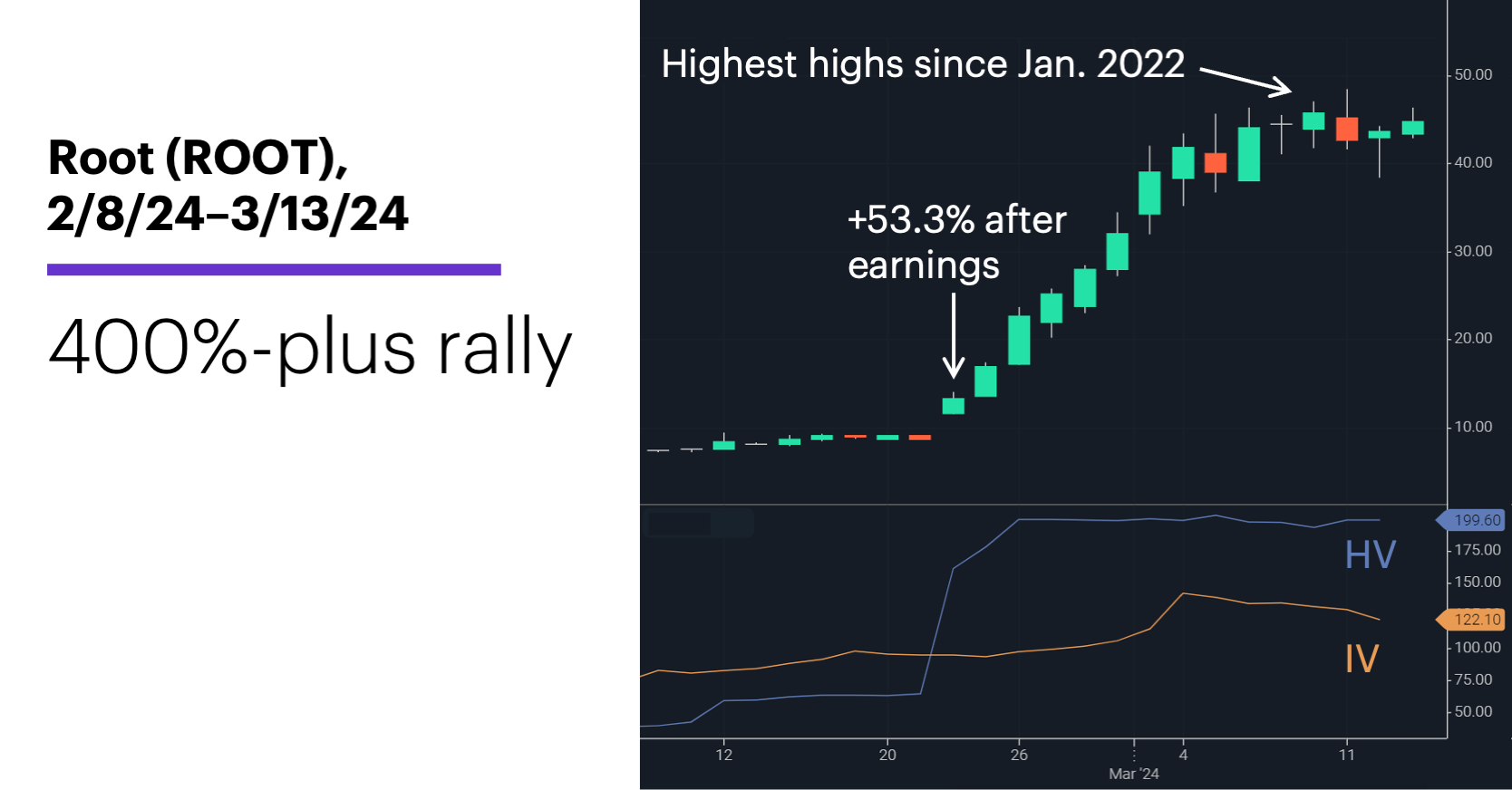Getting to the root of volatility
- ROOT shares more than quintupled in past three weeks
- Options IV near highest levels since late 2022
- High IV benefits options sellers more than buyers
Quick—think of the stock that drove the most headlines in February.
Nvidia (NVDA) is as good a guess as any. The AI-focused chipmaker’s earnings announcement was one of last month’s most highly anticipated market events, and the stock’s 29% gain for the month and continued run to record highs has given people plenty to talk about.
But another stock that released earnings the same day as NVDA made an even bigger splash than NVDA on the price charts, if not the news ticker—even though it posted a loss for the quarter. Not only did this stock more than triple NVDA’s percentage gain on February 22 (53.3% to 16.4%), it climbed 296% for the month and, as of Wednesday, was up more than 420% since February 21.
Was this another biotech stock surging on news of successful clinical trials, like Janux Therapeutics, or a bitcoin-related stock riding the recent crypto rally? No, it was auto insurer Root (ROOT):

Source: Power E*TRADE (For illustration purposes. Not a recommendation.)
While ROOT actually posted negative earnings, the loss was much smaller than analysts had expected, and revenues were better.1 The stock’s rally propelled it to its highest level since early 2022, although that’s still far removed from its all-time highs above $500 from late 2020.
While some traders may see the move as overdone and others may see the potential for more upside, all need to be aware of its impact on options prices. Although Root’s 30-day implied volatility (IV) has dipped in recent days, it’s still just a little below the 16-month high it hit on March 4, and that means options premiums are likely to be on the high side.
The “volatility constellation” below compares ROOT’s IV levels over the next few options expirations to their 30-day averages:

Source: Power E*TRADE (For illustration purposes. Not a recommendation.)
Even though IV drops significantly for the April, June, and September expirations, those levels are still above their 30-day average—and above 120%. To put that in perspective, NVDA’s volatility constellation showed the IV for its April options was 61%. Meanwhile, Meta (META), a stock that made a big move of its own in early February and is up around 40% so far this year, had April IV around 33%.
Translation: The options market expected much more volatility in ROOT than in either NVDA or META, and that uncertainty was being priced into its options. And that means options buyers—regardless of whether they thought ROOT would move up, down, or sideways—may have been paying inflated premiums to establish a position.
Options can provide flexibility, but it comes at a price: the need to factor in the effects of volatility and time. Depending on the situation, that can dictate whether it’s more advantageous to buy options or sell them.
Today’s numbers include (all times ET): weekly jobless claims (8:30 a.m.), Producer Price Index (8:30 a.m.), retail sales (8:30 a.m.), business inventories (10 a.m.), EIA Natural Gas Report (10:30 a.m.).
Today’s earnings include: Canadian Solar (CSIQ), Dollar General (DG), Dick’s Sporting Goods (DKS), GIII Apparel (GIII), Adobe (ADBE), Smartsheet (SMAR), Ulta Beauty (ULTA).
Click here to log on to your account or learn more about E*TRADE's trading platforms, or follow the Company on Twitter, @ETRADE, for useful trading and investing insights.
1 StreetInsider. Root (ROOT) Tops Q4 EPS by 120c. 2/21/24.